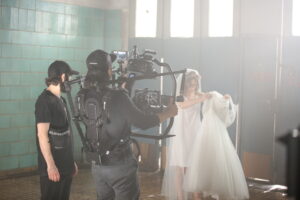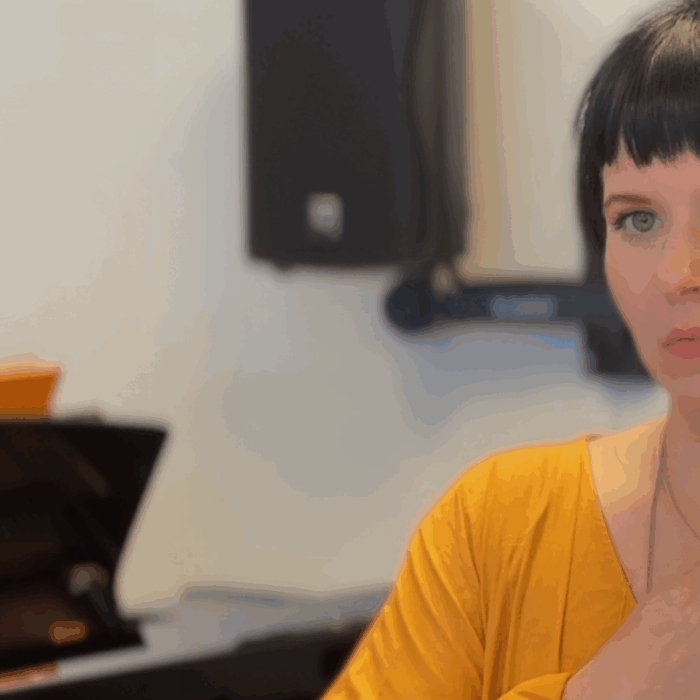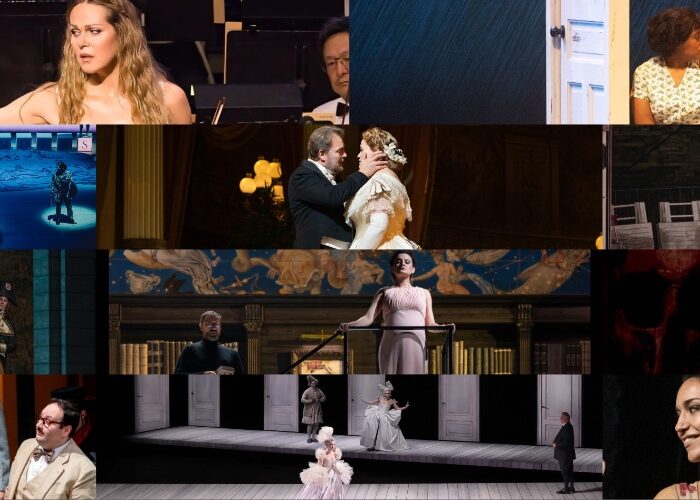
Opera Meets Film: In Conversation With Mario Bergmann About the ‘Opera Music Video’
By John VandevertHaving grown up with opera in the traditional format, meaning either you go and sit quietly while the opera is performed and only then do you show your adoration or you perform in the opera following a very strict set of procedures which you’re lucky if you get to extend as a soloist. My gut reaction to opera innovation is the question, “Why?” However, time and time again my skepticism is replaced with wonder at what can be achieved!
Whether it be a 24-hour opera like that of the sculptor Benjamin Orlow, an animated short-film entitled “Opera” by Erick Oh, or even a YouTube channel about complex horror narratives by an anonymous figure called “Conductor P,” there doesn’t seem to be any limit to what opera can look and sound like. With the advent of digital currencies and NFTs (Non-fungible tokens) like that of Living Opera, virtual reality (VR for short) and it’s increasing presence within the operatic world, one notable example being the Irish National Opera’s ‘community opera’ “Out of the Ordinary” among many other notable examples, opera has never had so many facets.
One facet is the music video. Operatic music videos aren’t a new concept per se, examples being Opera Australia’s video excerpt of their 2017 production of Bizet’s “Carmen.” Or, if you want a much earlier example there is the excerpt of the 1983 film of Verdi’s “La Traviata” by Franco Zefirelli and the seminal 1965 excerpt of Lucia Popp singing Johann Strauss II’s “Voice of Spring” as part of a larger concert. Two further examples bring the point home, that being the excerpt from the filmed production of Puccini’s “La Boheme” in 1971 starring Placido Domingo and Teresa Stratas and the excerpts of the 1976 film of Verdi’s “Tosca” starring Raina Kabaivanska among others, one of my favorites of all time. The point here is that the idea of a standalone music video of operatic material, while a potentially a novel form of operatic delivery, joins the rank of filmed opera that goes back quite a while! A quick search on YouTube shows some examples of opera and the music video including Elīna Garanča’s 2011 rendition of Camille Saint-Saëns’ “Mon coeur” and Megan Kaht’s 2018 rendition of “Song To The Moon” from Dvorak’s “Rusalka.” One of the most well-known music video settings of opera is the “Diva Dance” from the hit movie “The Fifth Element,” the opening being from Donizetti’s “Lucia Di Lammermoor.”
Movinapes Productions and their musical video featuring soprano Polly Ott and pianist Chelsey Padilla and their rendition of the aria, “À vos jeux, mes amis,” from Ambroise Thomas’ 1868 opera “Hamlet,” an opera which is quite rarely performed in theatres nowadays, is a step in a wonderful direction for opera. Set in a repurposed warehouse, with Ott in a subtly embellished wedding gown-styled white dress and a floral crown and Padilla in a subdued black suit, Ophelia’s “Mad Scene” is masterfully rendered through symbolism, tasteful histrionics, and a captivating ending which conveys the story and then some. But now, I will let Director Mario Bergmann do the talking!
OperaWire: What about the medium of the music video helps opera convey meaning?
Mario Bergmann: I think it’s finally time for opera to take over the music video world with beautiful and cinematic videos. But personally, it started with making aria videos/audition tapes for my wife, Polly and other opera singers, as well as producing promo videos for music labels. I always thought, it must be possible to make more out of these recordings. The aria format is basically like a music video and the music is so beautiful. You have characters, backstories and great opera already embodies so many of the elements of a compelling music video. Engaging performance, unique dramaturgy and prose, artistic wardrobe and set design; this is almost everything you’re hoping for when designing a music video. Film and music videos have always been influenced by opera.
The music video is basically a genre with its own aesthetic tendencies and patterns. We saw an opportunity to reunite the two. We watched different videos for inspiration and came across opera recordings made for TV from the 70s. For example this film with Anna Moffo in “Lucia di Lammermoor” (Donizetti) 1971. We thought that this is something close to what we wanted to make but just in a modern minimalistic version. Not to make an entire opera film but allow opera to find a presence in the world of music videos, bridging the gap between traditional opera and contemporary media consumption. We will never be able to fully capture the feeling of being in the theater and experiencing the energy of live opera. Thankfully, that isn’t our goal. But video does afford us some unique opportunities that can impact a viewers experience in different ways.
We can cut into close-ups, we can manipulate time and rapidly move through space with ease, and immediately dilate one’s attention between grand scope and small detail. There is so much potential in visualizing arias. It can become a way to introduce a new audience to opera with a familiar format and visual language. Stepping up the aria-game without trying to make opera cool but to highlight its relevance as an art form and make it accessible. And, hopefully, provide opera lovers with a different way to experience the medium.
OW: What about the music and your idea sought it necessary to expand upon the aria’s theme?
MB: Most opera videos I have seen are mainly live performance recordings or someone singing and standing in front of a piano. A live performance video can be emotional and moving, but it is a documentation. We wanted to create our very own mini-opera in a music video format so we chose a stage-like location to set a mood, keeping it minimalistic and open to interpretation. It could be a castle Ophelia is trapped in, a modern day wedding location she was trying to escape from or it can be the visualization of her mind. The aria itself gave us different sections we could explore within our created world. We used staging tools like you would in live opera: light change, props and abstract symbols representing the aria’s theme and world. We wanted the opening scene to feel like the start of a recital which then transforms and breaks free into more narrative storytelling, reflecting Ophelia’s emotional journey.
The water reflections on Ophelia’s face in the blue room, might have been just a nice effect in a pop video but here we used it to symbolize her eventual drowning. Filmmaking techniques makes it feel more intimate or distanced, adding another layer of experiencing the aria. Another aspect was featuring the pianist as its own character. Seeing the pianist was crucial to make the pre-recorded audio feel real and believable in the location but also gave us storytelling opportunities and visual variety. Compared to an experience in a live opera where performers are often far away, the close-up in our film highlights the emotional expressions and the singer’s acting talents become more visible. Filming with playback allows singers to perform in uncommon stagings like Polly lying on the floor surrounded by the roses. That wouldn’t be possible on the live stage or at least very limited and hard to sing properly. By including nods to famous art, like John Everett Millais’ “Ophelia” painting, we hope the audience will recognize it and feel excited. Shared characteristics of opera and film; creating images like living paintings.
But in that process we sat and thought about Ophelia, her story, her suffering, and asked ourselves how do we film it in a way that is both familiar as a music video but also familiar to fans of the opera. We focused on Ophelia’s mind – the prison of her memory and the burden of her hope. Members of our film crew who have never experienced opera before were deeply moved by the music during this production. Some of them even became fans. Our assistant video editor started exploring the world of opera and has now attended several operatic performances in Berlin. She even formed an opera-goers Whatsapp group with other friends who are new to the genre. It doesn’t always have to be the big opera house. It can also be a small recital or a house concert. This is all opera.
OW: What are the implications of this type of remolding of the operatic aria?
MB: Our goal is not to remold filmed opera but maybe modernize its aesthetics and format. Our inspiration, the film with Anna Moffo I mentioned earlier, showed that similar things have been done before but then weren’t developed further or adapted into a contemporary way of making videos. I also think that the technical possibilities weren’t accessible for every filmmaker for a long time. Today we have many tools available to create stunning videos with fewer resources. Creating an opera music video format is also a technological evolution. Recognizing the importance of social media in contemporary culture, we also had shareability in mind, crafting visually impactful moments that resonate on social platforms.
Our dream would be to expand opera – both its reach and how it’s experienced. To people who are new to this world, opera can be intimidating because there seems to be this misconception that in order to enjoy opera, you need to study it or have some expert guide. Both of these things absolutely can enhance the experience but it is also ok to watch an opera and be emotionally touched, simply by the harmonies, the powerful voices and expression of the singers. By moving single arias into a familiar space of music video, we’re hoping to expose people to the art in a way that helps them realize that opera is and always has been accessible. Opera singers were the first rock stars. By taking Ophelia’s aria and placing it outside of the opera’s context, we’re trying to create a comparable format to a single of a pop album. But placing the aria into the space of music videos, doesn’t mean that we simply copy the way a pop music video is made.
We still need to create visuals that fit for opera. In my view, editing to the pace of the music of opera is especially important. We didn’t want to just show colorfully lit images like a rap video and use fast edits. The way the video is made always needs to reflect the music. Staying true to the core of opera and using visual storytelling from familiar formats, opera and classical music newbies may be able to understand the beauty of an aria, without ever having watched an opera before. This has the power to spark an interest in exploring the entire world of opera.


